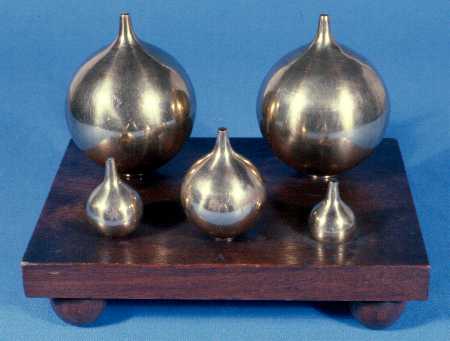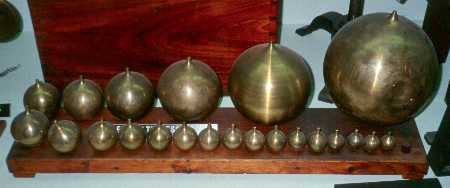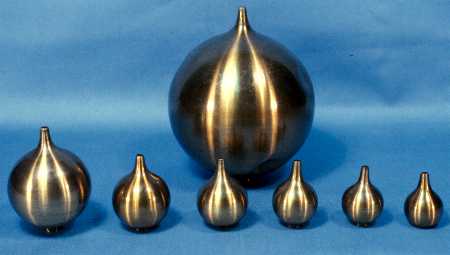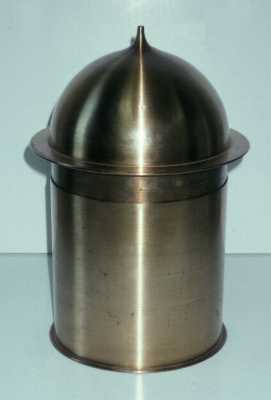Helmholtz Resonator
The research of Herman L. F. von Helmholtz (1821-1894)
straddled the interfaces between physics and physiology and psychology.
His book,
On the Sensations of Tone, published in 1862, at first
appears to be on music and its perception, but on a deeper examination,
is also a classic textbook on the subject of vibrations. Helmholtz and
Koenig were at the University of Königsberg in East Prussia at the
same time about 1850 and undoubtedly knew each other.
The book describes the form of resonator that he
developed for picking out particular frequencies from a complex sound.
This consists of a body to contain a volume of air, a hole or neck in which
a slug of air can vibrate back and forth, and a slender nipple that can
be held in the ear canal (or, today, connected to a sound level meter).
The enclosed volume of air acts as a spring connected to the mass of the
slug of air, and vibrates in an adiabatic fashion at a frequency dependent
on the density and volume of the air, its molecular composition, and the
mass of the slug of air in the neck. The system is just the same as that
used to find the ratio of the specific heats of gases using Rüchardt's
method.
| Koenig made both cylindrical and spherical
Helmholtz resonators. Until 1860 Helmholtz had been using as resonators
whatever glass cylinders and tubes were at hand; about that year he asked
Koenig to make metal resonators of both shapes to specific measurements
for more careful work.
A set of spherical resonators at the University of Toronto
is shown at the right. The 1889 Koenig catalogue does not list a set of
five resonators, but these, on their original base, must be part of the
collection of acoustic apparatus that Toronto bought from Koenig after
the 1876 Centennial Exposition in Philadelphia. |

|
 |
This very large set of twenty two Helmholtz resonators is in
the Garland Collection of Classic Physics Apparatus at Vanderbilt University.
These were bought by Chancellor Garland to outfit the Vanderbilt physics
department for the opening of the university in 1875. Garland had previously
gone to visit Koenig in Paris to discuss his order. in 1889 a set of nineteen
resonators cost 170 francs. |
| Father John A. Zahm, Professor of Physics
at Notre Dame in Indiana, visited Koenig, and wrote a book on acoustics
based on Koenig's apparatus. He often bought two sets of apparatus, one
for Notre Dame and one for St. Mary's College for Women just to the west.
The nuns took good care of their apparatus, and this set of seven Helmholtz
resonators is one of the many survivors at St. Mary's. |
 |

|
The resonant frequency of a Helmholtz resonator depends on its
volume, and a cylindrical resonator permits the volume of the resonator
to be changed by sliding the tubes in and out. The notes (and hence the
resonant frequencies) are engraved on the side of the apparatus. This is
one of a number of tunable Helmholtz resonators at the University of Vermont.
Quite similar resonators were made and sold by the firm
of Max Kohl
of Chemnitz in Germany.
|